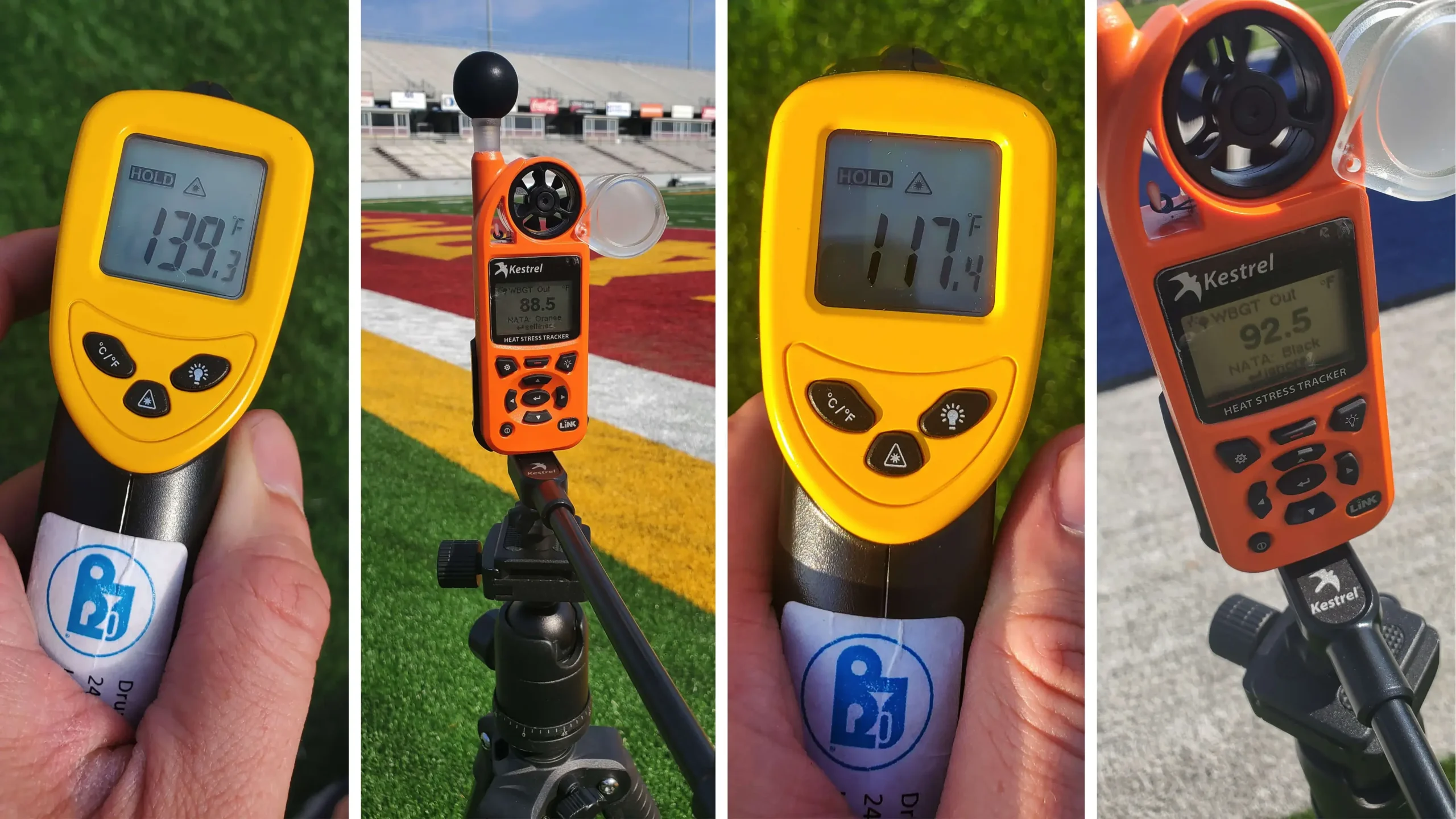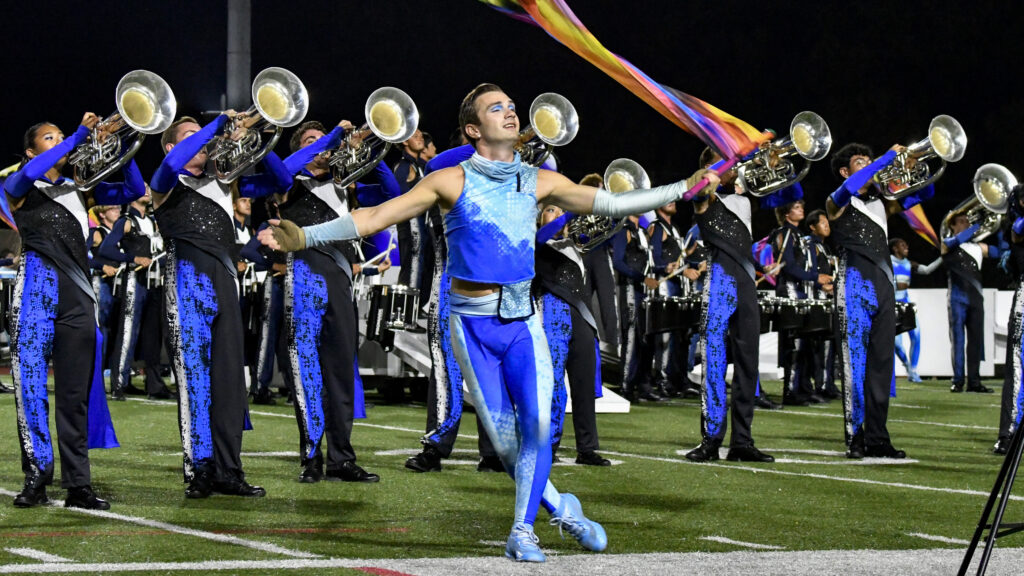Dr. Kevin Kloesel is the director of the Oklahoma Climatological Survey and a meteorologist for the Oklahoma University Department of Campus Safety who works as part of DCI’s Marching Arts Safety & Health initiative. Kloesel sat down with DCI’s Dan Potter to discuss developing issues and conversations related to the intersection of weather patterns and drum corps. The following transcript of their conversation is lightly edited for length and clarity.
Dan Potter: You are charged with helping to keep performers safe in weather situations. And there’s always been discussion about storms and lightning and rain. But the last five years, what’s dominated the weather discussion in drum corps has been heat. What trend have you seen in the last five years?
Dr. Kevin Kloesel: In today’s marching music activity, corps have their team of administrative staff/instructors. They’ve all marched in drum corps, but they marched in a different climate. And their notion of hot is not today’s notion of hot.
We’ve been taking detailed measurements for the last five years on almost every event performance surface and rehearsal venue surfaces. What we’re noticing is a deterioration of comfort. The human-comfort side of heat. Performance surfaces like artificial turf can get incredibly hot, dangerously hot, over temperatures that can burn skin.
We also have this combination of lack of wind, even in Oklahoma with high humidity, high temperatures, sunshine, and really looking at the enhancement or increase in the number of heat-related illness cases that we’re seeing across corps. But this same increase is happening across almost every summer activity, whether it’s band or an athletic pursuit. It could be tennis, soccer, football, you name it. We’re seeing increases across the board and our emergency rooms across the country are bearing this out. The emergency room heat numbers are going up and particularly through the months of April through September. Of course, drum corps season is right smack in the middle of that.
Potter: What do you think is the number one thing that corps directors and instructors need to be aware of because of climate change?
Kloesel: First of all, the directors have been very much embracing the change. We’ve seen already our ability to move the start times of events, particularly in Texas, across the South, to after sunset. After sunset, once the sun goes down, heat and illness risk does in fact decrease. That’s provided we’re not out in the middle of it, all day long, or at least taking the necessary precautions, hydration, etc. But the willingness to change is going to be the key here.
If we’ve already seen this willingness to change events and event times, now it’s a question of, can we change the structure of rehearsals? Can we move things to earlier in the morning or to later in the evening? Can we do more intellectual or mental type of work during that heat in the afternoon where we’re still giving the performers the necessary training and instruction that they need, but not doing it where they’re being taxed both physically and mentally by heat? Because the heat does impact both. Your cognitive as well as physical.
Potter: In the presentation you just gave at the DCI Winter Meetings, you pointed to an event at Prairie View A&M in which there was an event going on, a camp during the day and then a massive event during the evening where almost 40 people got sick after sunset.
Kloesel: Right, it was a mass casualty event due to heat. This heat issue is not instantaneous. Heat is cumulative. So your susceptibility to heat illness increases the more exposure you get. You can almost think about this from a standpoint of, you have a full glass of water and you drink half of it, but you only put a little bit back in. So the next day you’ve only got just over half of that water. Well, you drink most of it. The next day you put a little bit back in, you’ve still got a little bit of water, but now you’re farther down the heat illness spectrum on day two, day three, day four. The effects are cumulative. This Prairie View A&M incident happened during an orientation week. It was a week-long activity. And unfortunately, these are our kids, too, right? Same age, mostly university students, many of them band students on a football field, on an artificial surface in Texas in August. And this cumulative effect ultimately broke into a mass casualty event after dark. You had people who had to be airlifted because they were in such bad shape. 40 kids, university students going to the hospital because of something that was preventable.
And that’s where we are looking at these kinds of events and seeing parallels to what we do in drum corps. We have to think about how we mitigate heat and how we recharge our performers so that they can give the best shows when our fans come to see them.
Potter: How do you think Dum Corps International and its corps have done with that assignment?
Kloesel: We’re making progress, but we’re not there. We’ve still got a lot of work to do, but it’s not going to happen overnight. At this point, like I said earlier, the ability to change an event time, that’s a big deal. We’ve had lengthy discussions about whether or not something like that can be done sooner and more proactively. Those are the right questions to be asking. From a director standpoint, those should be the demands of the meteorology group to provide the expertise to make us safer. And I’m pleasantly surprised that we were charged to do that. That shows sort of a shift in how we think about heat.
Potter: Do you expect 2024 will set a heat record like 2023?
Kloesel: I do, I think so. We’re in an El Niño pattern in the Pacific. That’s, fancy weather-weenie, nerdy jargon for “It’s going to be hotter.” Because of warm temperatures in the Pacific, we’re still looking at this not going away.
Potter: What’s the number one change you’d like to see made?
Kloesel: Our ability to impact a rehearsal schedule to make sure that our performers have the best opportunity to give that ultimate performance for the fans. Are they the freshest they can be while maintaining excellence? Maintaining that level, that bar that DCI has set from a performance standpoint, how do we maintain that or enhance it by the changes we put into a rehearsal schedule, particularly on a show day? I think we can make modifications to a rehearsal schedule so that you don’t lose any instruction. Those are the kinds of things I would love to see.
Potter: Just to put an exclamation point on all of this. Heat is now the number one weather-related killer, correct?
Kloesel: Yes, and it dwarfs all of the others combined. You add tornadoes, you add hurricanes, you add floods, you add cold, snow, ice, you name it. You add all of those up, they do not meet the number of fatalities we see directly due to heat.
Help support the continued efforts of the Marching Arts Health & Safety initiative
Since its inception in 2007, the Drum Corps International-sponsored Marching Arts Health & Safety initiative (MASH) has succeeded in bringing together health care professionals from varied disciplines to provide medical guidance and hands-on assistance to corps members during the DCI Summer Tour.
 With an initial focus on injury prevention and treatment, participation in the project has grown from a handful of volunteer contributors to an expansive network of practitioners and professionals throughout the United States. The program is now poised to serve an even greater audience of performing arts athletes with development of “best practices” already impacting the marching band activity nationally and internationally with continued research and medical expertise, environmental and other safety areas.
With an initial focus on injury prevention and treatment, participation in the project has grown from a handful of volunteer contributors to an expansive network of practitioners and professionals throughout the United States. The program is now poised to serve an even greater audience of performing arts athletes with development of “best practices” already impacting the marching band activity nationally and internationally with continued research and medical expertise, environmental and other safety areas.





